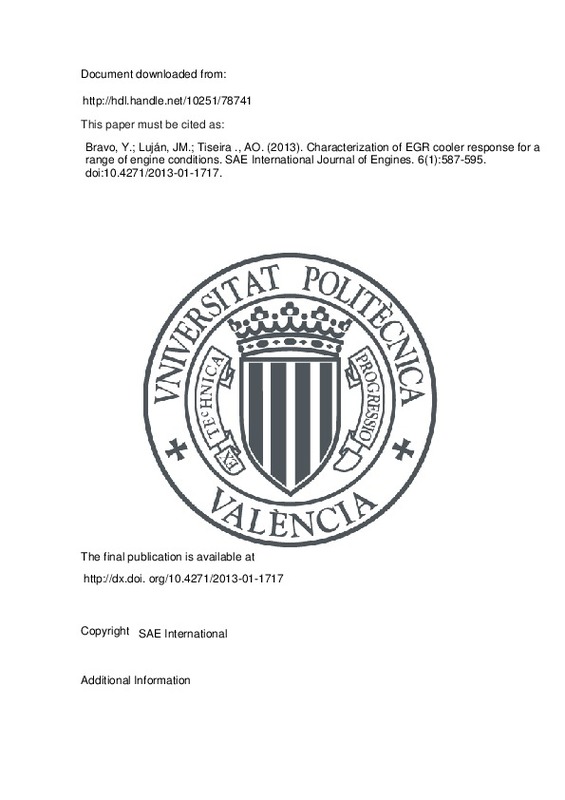JavaScript is disabled for your browser. Some features of this site may not work without it.
Buscar en RiuNet
Listar
Mi cuenta
Estadísticas
Ayuda RiuNet
Admin. UPV
Characterization of EGR cooler response for a range of engine conditions
Mostrar el registro sencillo del ítem
Ficheros en el ítem
| dc.contributor.author | Bravo Valeo, Yolanda
|
es_ES |
| dc.contributor.author | Luján, José M.
|
es_ES |
| dc.contributor.author | Tiseira ., Andrés Omar
|
es_ES |
| dc.date.accessioned | 2017-03-14T08:38:04Z | |
| dc.date.available | 2017-03-14T08:38:04Z | |
| dc.date.issued | 2013 | |
| dc.identifier.issn | 1946-3944 | |
| dc.identifier.uri | http://hdl.handle.net/10251/78741 | |
| dc.description.abstract | Fouling phenomenon is a key issue for EGR cooler operation. In spite of the fact that soot deposition is imposed by the characteristics of the exhaust gases flow, the design of the EGR cooler has a significant impact for effect on the engine. New combustion modes corresponding to new engine developments and combination of EGR system with other posttreatment devices make that fouling conditions for future generations of EGR coolers can be significantly different from previous applications from Euro 3 to Euro 5. An investigation has been performed in order to characterize the response of different EGR coolers designs for different conditions of the exhaust gases. As for the design, the technology selected has been tube-and-fin heat exchanger, which is a high performance technology that fits Euro 6 customer specifications. The variations in design have been made through modifications in fin characteristics, both in configuration and geometric dimensions. As for engine operation conditions, the exhaust gases characteristics have been modified from a standard calibration to get more severe fouling conditions, in terms of HC content, opacity, exhaust gas temperature and flow. The degradation of performance has been characterized through measurements of thermal efficiency and permeability. It can be concluded that HC content and opacity have a significant influence on fouling phenomena, and that EGR cooler optimum design is highly dependent on these exhaust gas conditions. | es_ES |
| dc.language | Inglés | es_ES |
| dc.publisher | SAE International | es_ES |
| dc.relation.ispartof | SAE International Journal of Engines | es_ES |
| dc.rights | Reserva de todos los derechos | es_ES |
| dc.subject | Customer specifications | es_ES |
| dc.subject | Engine development | es_ES |
| dc.subject | Exhaust gas temperatures | es_ES |
| dc.subject | Future generations | es_ES |
| dc.subject | Geometric dimensions | es_ES |
| dc.subject | High-performance technologies | es_ES |
| dc.subject | Standard calibration | es_ES |
| dc.subject | Thermal efficiency | es_ES |
| dc.subject | Design | es_ES |
| dc.subject | Engines | es_ES |
| dc.subject | Exhaust gases | es_ES |
| dc.subject | Fins (heat exchange) | es_ES |
| dc.subject | Fouling | es_ES |
| dc.subject | Opacity | es_ES |
| dc.subject.classification | INGENIERIA AEROESPACIAL | es_ES |
| dc.subject.classification | MAQUINAS Y MOTORES TERMICOS | es_ES |
| dc.title | Characterization of EGR cooler response for a range of engine conditions | es_ES |
| dc.type | Artículo | es_ES |
| dc.identifier.doi | 10.4271/2013-01-1717 | |
| dc.rights.accessRights | Abierto | es_ES |
| dc.contributor.affiliation | Universitat Politècnica de València. Escuela Técnica Superior de Ingenieros Industriales - Escola Tècnica Superior d'Enginyers Industrials | es_ES |
| dc.contributor.affiliation | Universitat Politècnica de València. Escuela Técnica Superior de Ingeniería del Diseño - Escola Tècnica Superior d'Enginyeria del Disseny | es_ES |
| dc.description.bibliographicCitation | Bravo Valeo, Y.; Luján, JM.; Tiseira ., AO. (2013). Characterization of EGR cooler response for a range of engine conditions. SAE International Journal of Engines. 6(1):587-595. doi:10.4271/2013-01-1717 | es_ES |
| dc.description.accrualMethod | S | es_ES |
| dc.relation.publisherversion | http://dx.doi.org/10.4271/2013-01-1717 | es_ES |
| dc.description.upvformatpinicio | 587 | es_ES |
| dc.description.upvformatpfin | 595 | es_ES |
| dc.type.version | info:eu-repo/semantics/publishedVersion | es_ES |
| dc.description.volume | 6 | es_ES |
| dc.description.issue | 1 | es_ES |
| dc.relation.senia | 255094 | es_ES |







![[Cerrado]](/themes/UPV/images/candado.png)

